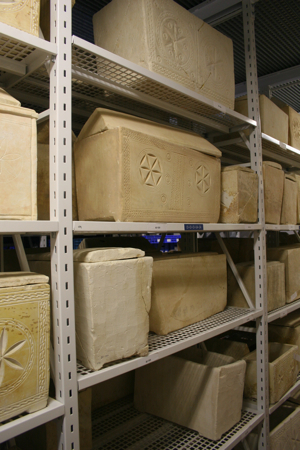The Talpiot “Jesus” Tomb: What Might Have Been–The Ossuaries
I am not archaeologist, my training is as a Biblical scholar, a historian of religions, but over the past 20 years I have had a considerable amount of archaeological experience. Surely all would agree that the most basic field instruction, truly Archaeology 101, is the obvious necessity at any excavation to correlate finds removed from a site with their loci or locations at the site! If any of our students found a coin, and just picked it up, ran over to show me or Dr. Shimon Gibson, with whom I work, our first question would be–why did you move it! Where did it come from? We have to record, either by photography or in written form, precisely where things were found before they are moved. The student, no matter how excited about his or her find, would have committed a grave mistake. Nothing is removed before it is recorded.

The two tombs in East Talpiot are quite in instructive in this regard, one discovered in 1980, the other a year later in 1981. In the case of the latter, which we have called the “Patio” tomb, or Talpiot tomb B, photos were made of the ossuaries in the tomb in situ before anything was moved. This has been a tremendous benefit to us as we have recently explored this tomb, now under the patio of a condominium building, remotely with cameras, particularly since the ossuaries were moved in the preliminary examination of the tomb and are not now in their original places. That is how we know the “Jonah” ossuary was the first on the right, when one entered the tomb, giving it a place of prominence, that we have taken as significant. See my original report with photos here what we have subsequently learned here.
But in the case of the former tomb, the so-called “Jesus” tomb, there are no such photos available! It is one of the many unanswered questions about how the excavation of that tomb was conducted over Easter weekend in 1980 which I have summarized here. We have are clear photos of nine of the ossuaries that were taken by the Israel Department of Antiquities (today the Israel Antiquities Authority) once they reached the Rockefeller where they were tagged and catalogued (IAA 80.500-509). We also have a very fine and detailed map done by young Shimon Gibson at the time of the excavation showing the locations of all ten of the ossuaries grouped in their various kokim or niches, with each numbered and lettered a, b, or c. Gibson has explained that when he did his map the ossuaries had already been removed but he was able to draw their locations based on their imprint in the soil around them.
What we lack, and this loss is rather astounding to contemplate, is any way to correlate the ossuaries removed from the tomb with their original locations as shown on Gibson’s map!
For example, notice the first niche on the right as you come into the tomb entrance had three ossuaries grouped together–but we have no idea which three, and whether they were inscribed or uninscribed with names. Can you imagine the difference it would make in our discussions of this tomb if it turned out that the ossuaries inscribed “Yeshua son of Joseph,” “Yehuda son of Yeshua,” and one of the women–either Maria or Mariamene, were in that first niche? That, along with the DNA tests we were able to do on skeletal remains of the Yeshua and Mariamene ossuaries might go a long way as to telling us who was most likely the mother, and thus the wife, of the Yeshua in this tomb. Or perhaps the ossuary inseribed “Yose” was paired with another in one of the three niches that had two ossuaries. Knowing these original locations would surely be of great interest.
When I did my initial research on the Talpiot tombs in preparation for my book, The Jesus Dynasty, published in 2006, I carefully checked with both Shimon Gibson and Amos Kloner as to whether there might possibly be any other records on this tomb. Gibson had nothing but his drawing and Kloner gave me his official reply in writing:
I don’t have any further information concern the location of each ossuary which matches the catalogue numbers. It should be explained that the burial chamber was filled with dirt of about 50 cms high and the ossuaries were not seen in the first visit of mine at the site. Very little was written by Gat and nothing concern this burial was included in the few papers submitted to me by Ruth Gat his widow, after he passed away. [1]
I am not interested in assigning blame here so much as expressing regret at this loss of such basic information. It would be interesting to know if this kind of basic failure to record the loci of artifacts in various tomb excavations of the time was typical or atypical.
This gap in our knowledge has spurred some heroic efforts to make up for the loss, the most ambitious surely by John Koopman, who has helped me with my own research. John had the idea, knowing Shimon’s proclivity for accuracy and exactitude, of taking his map and trying to correlate the shape and sizes of the ossuaries in the drawing with the actual dimensions of the nine ossuaries in the Israel State Collection, that is their relative lengths and widths. Shimon Gibson later told me he had tried to do the same thing. John’s diligence is truly admirable and his results are quite fascinating, but unfortunately inconclusive.

